

Sony Alpha 9 Mark II (ILCE-9M2): a mirrorless professional system camera with full-frame sensor that performs impressively on the microscope
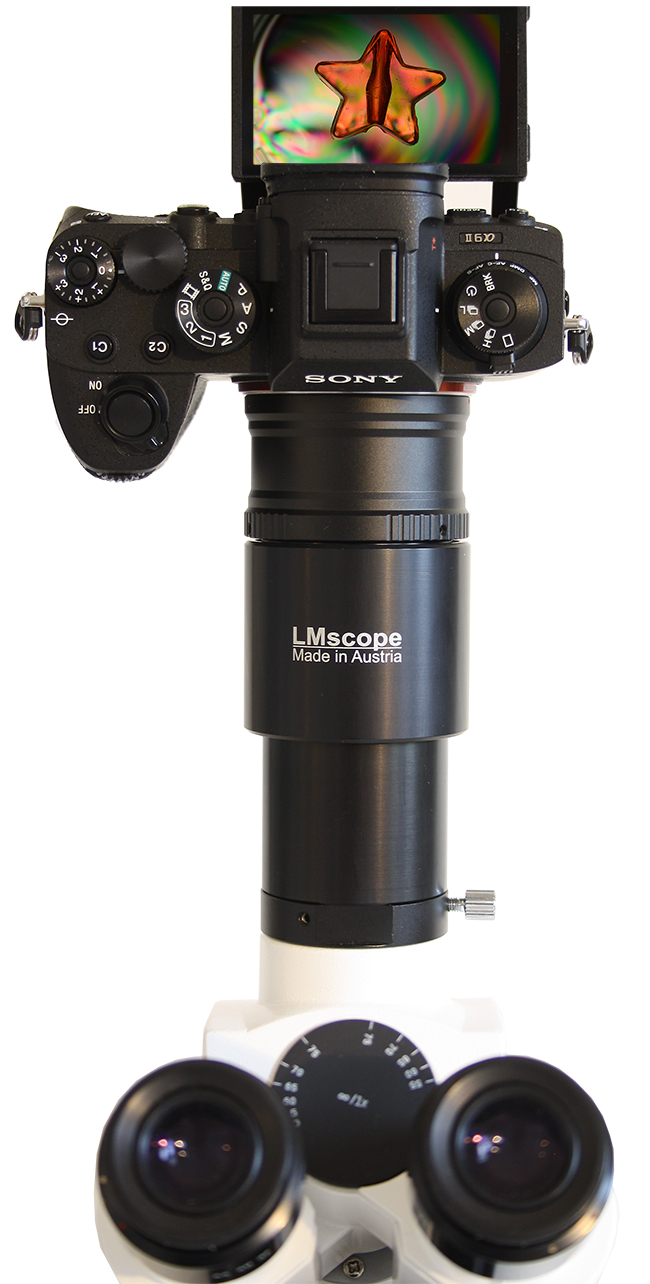
Sony’s Alpha series system cameras have been a go-to for demanding tasks in professional photography for many years. The Alpha 9 II features state-of-the-art camera technology and a powerful sensor and is therefore ideally suited for use with a microscope. The large sensor format enables high-resolution, high-sensitivity image capture. The camera’s excellent speed performance combined with added connectivity and network capabilities drastically improve the professional workflow. In terms of image quality, the camera outperforms conventional C-mount microscope cameras in almost all aspects.
Key specifications of the Alpha 9 II:
- 24.2 MP Exmor R CMOS full-frame image sensor
- Integrated port offers 1000BASE-T speeds for quick wired LAN sharing
- Continuous shooting at up to 20 fps
- Electronic shutter speeds up to 1/32000 second
- Power connection via USB-C
- 4K video
- 5 GHz Wi-Fi® for high-speed data transfer
- Remote Camera Tool
- Imaging Edge Mobile app
- Capture One (for Sony)
- Imaging Edge Remote, Viewer and Edit for desktop
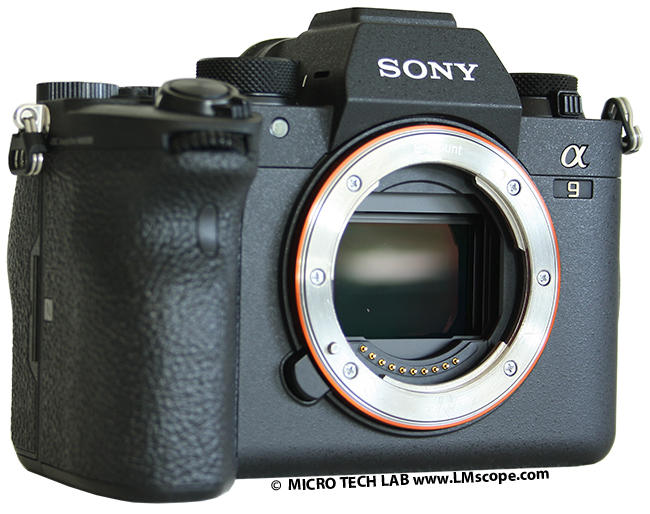
The Sony Alpha 9 II has a stacked, back-illuminated, full-frame (35.6 mm x 23.8 mm) 24.2 MP EXMOR® RS CMOS sensor with integrated memory. The incredibly fast BIONZ X™ processor enables continuous shooting speeds of up to 20 fps with electronic shutter at full resolution and thus more than measures up to the Alpha 9 II’s predecessor. It is also possible to shoot up to 10 fps using the mechanical shutter, which means that the dreaded rolling shutter effect can largely be avoided and moving objects such as insects or microorganisms, but also fast sequences such as manufacturing processes or chemical reactions can be captured with pinpoint clarity.
When shooting with the mechanical shutter in manual mode, shutter speeds from 1/8,000 to 30 seconds are available, and 1/32,000 to 30 seconds with the electronic shutter. The camera also has a Bulb feature, which adds a great deal of flexibility when it comes to shooting long exposures. The electronic shutter enables completely silent continuous shooting, and the vibration of the mechanical shutter has been reduced to an absolute minimum with a low-vibration design. Having the option to choose between the electronic and mechanical shutter optimises the shooting process and therefore enables superior image quality. A mechanical shutter uses conventional shutter curtains located in front of the sensor. The advantage of this type of shutter is that it exposes the whole sensor all at once and then completely blocks it after the exposure is finished. The focal plane shutter protects the sensor from additional light, and the image signals are read out without any more exposure taking place. This is a big benefit over C-mount cameras, which have no focal plane shutter. When shooting images of fast-moving scenes, there is often time for a subject to move slightly as the electronic shutter closes line by line. This will allow additional light to be captured by the sensor because the electronic shutter has a much slower readout. The result is a blurry, distorted image.
Demo photo of a plastic component in polarised light at about 20x microscope magnification, ISO 100. The large dynamic range enables richer colours and a greater colour range, and small differences are brought out in more detail.
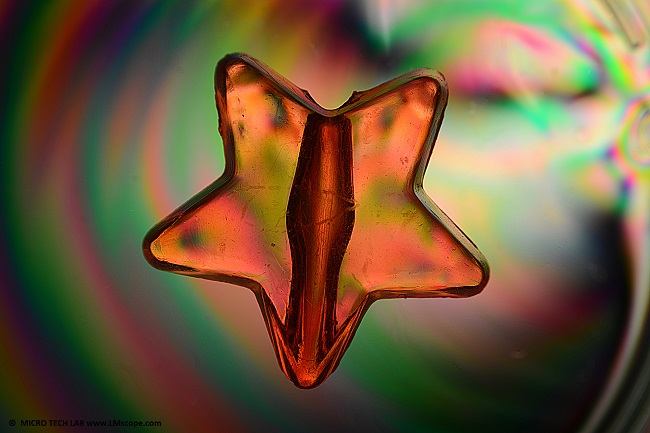
The Alpha 9 II is slightly larger and weighs 90 grams more than its predecessor. Its body is very sturdy, which makes it a great choice for outdoor applications, but it performs equally well in a laboratory setting. With our LM DSLR adapters, which feature built-in plan-achromat optics, the camera can be attached to almost any microscope in a few quick and easy steps.
To use the camera with a non-CPU lens, the Release w/o Lens setting must be enabled in the camera menu:
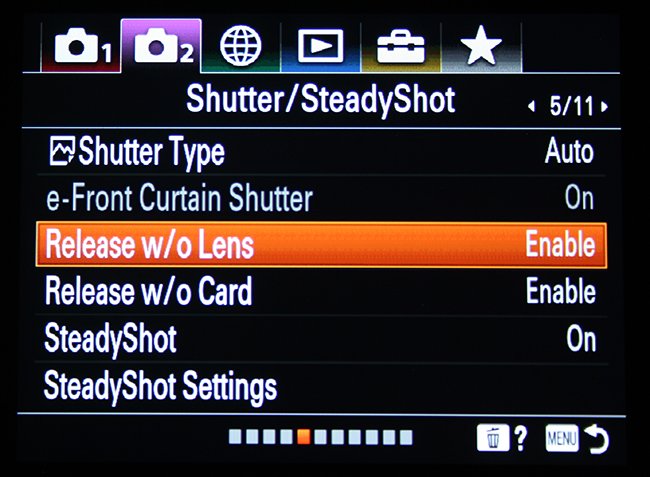
Shown in the image below: the camera attached to the vertical phototube of a microscope. The high-quality LM microscope adapter is attached directly to the camera body to make a firm mechanical connection between camera and microscope. It has an integrated plan-achromat precision optical system, which enables the size of the camera sensor to be matched precisely to the microscope being used and produces a large field of view with sharp focus all the way to the edges. Thanks to its modular design, the adapter solution can be adjusted to suit the requirements of any given application.
To utilise the powerful features of the Sony A 9 II to their full extent, we recommend modern microscopes with an infinity-corrected optical path in combination with plan or, ideally, plan-apochromat objective lenses. Differences in the quality of the lenses used, no matter how unnoticeable when looking through the eyepiece, will show up in the photos the camera takes.

If the microscope does not have a dedicated phototube, it is also possible to attach the camera body to the eyepiece tube with the corresponding LM adapter solution. To attach the camera, one eyepiece is removed and the camera, together with the adapter unit, is inserted into the tube where the eyepiece was. The image quality of the eyepiece solution is as good as that achieved using the phototube solution. The adapter has a built-in wide-angle lens which enables the camera to capture the largest possible field of view without any peripheral darkening.
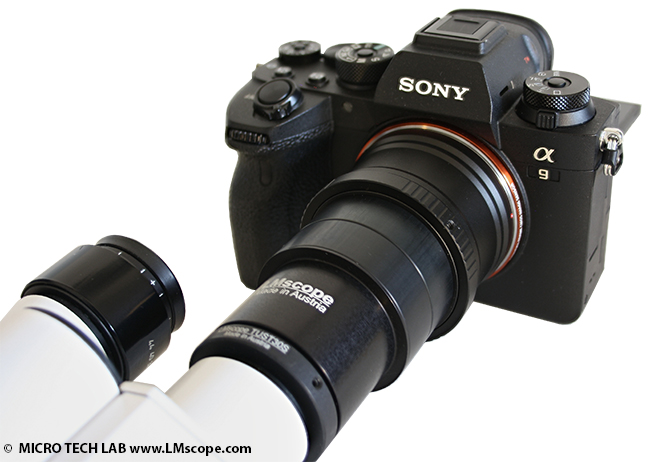
Use on special microscopes with central optical path:
Most professional images, where maximum image quality is important, come from microscopes that have a centric optical path, because these produce better image quality and are therefore more suitable for photography. Such systems are available from many big-name microscope manufacturers, and LMscope, too, has an instrument in its product range that offers these qualities: the LM macroscope/ photo microscope. Fixed focal length lenses are imaging lens assemblies designed with a single angular field of view. They deliver high image quality because they are designed for optimal performance at a single specified focal length. Zoom lenses, on the other hand, which allow the focal length to be continuously varied, are more comfortable to use, but do not deliver the same impressive image quality. A short working distance also increases optical resolution (numerical aperture).
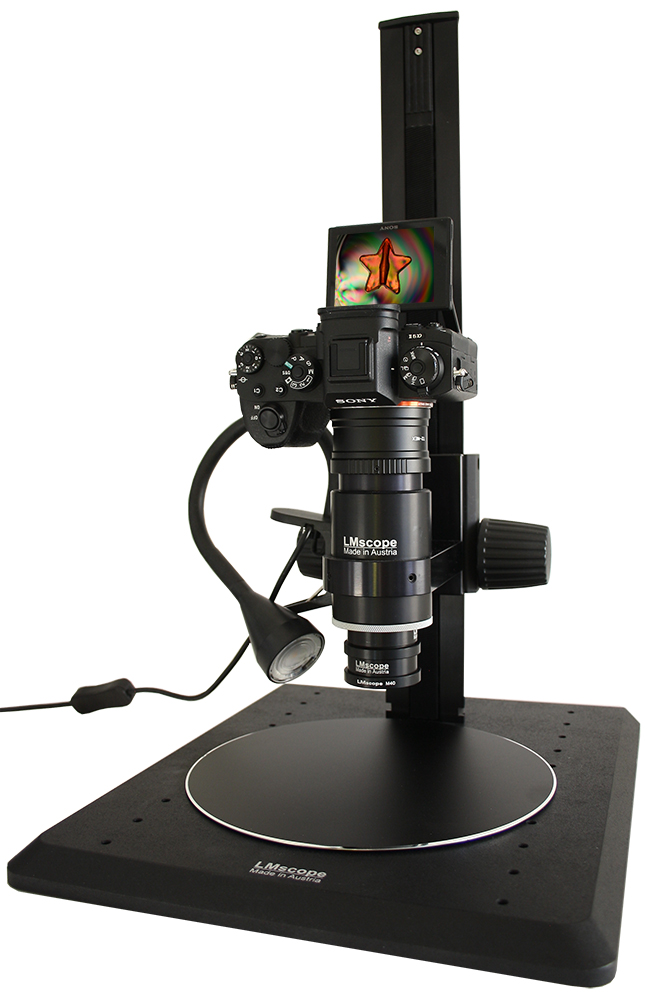
Use on microscopes with motorised stands and focus stacking:
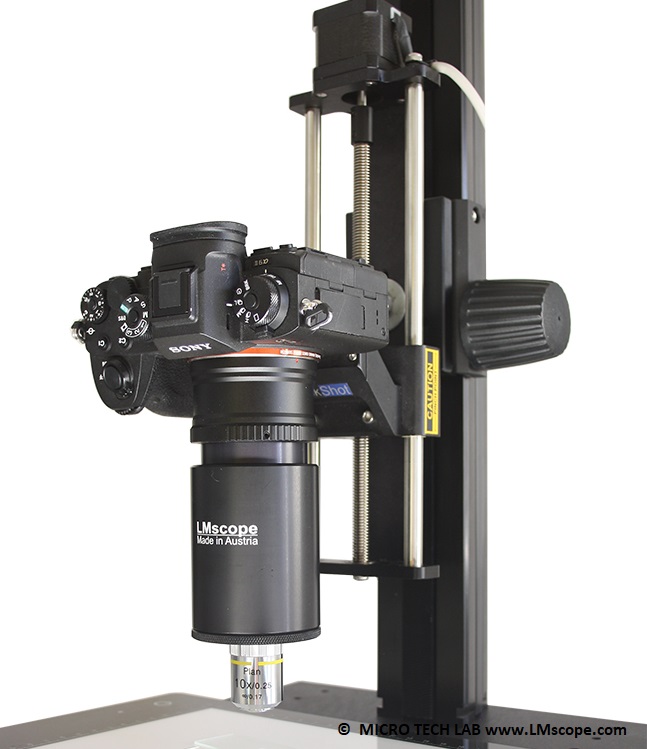
Focus stacking is a digital image processing technique designed to achieve a deep depth of field and high-resolution images by blending (or stacking) several images together: with a motorised focusing rail, the camera automatically takes a series of images, gradually changing the focus distance between them. It is not uncommon that over a hundred individual frames are used to create one perfect composite image. In our tests, we used the popular StackShot focusing rail combined with the Helicon focus stacking software. When using Helicon, both the camera and the focusing rail are connected to the computer with a USB cable. The image capturing process is controlled remotely from the computer, and the individual images are written directly to the hard drive. The live images are displayed on the computer monitor, with the distance that the objective will move in the z-axis between each captured image highlighted. With this convenient technique, photographers can capture stunning images with razor-sharp precision and professional quality focus. Many of the amazing pictures published on the internet and in magazines have been created with focus stacking.
Unfortunately, at the time of this review, the Helicon Remote software cannot control the camera via the USB cable. The Alpha 9 II does not show up in the list of compatible cameras provided on the manufacturer’s website, This means that the camera is not supported by the software and therefore cannot be used for tethered shooting from the computer. As an alternative, the live image can be displayed on the camera screen or on an external monitor to adjust the focus via this interface. The StackShot controller is connected to the remote shutter port with a shutter interface cable. The control unit is then used to trigger the camera’s shutter. The live view images of the Sony Imaging Edge software can also be used to control the camera remotely.
The Alpha 9 II has a standard Sony E-mount system, which has been used in mirrorless system cameras for many years – both in smaller APS-C sensor cameras and in higher priced full-frame cameras. Our LM microscope adapters are screwed directly onto the camera body.
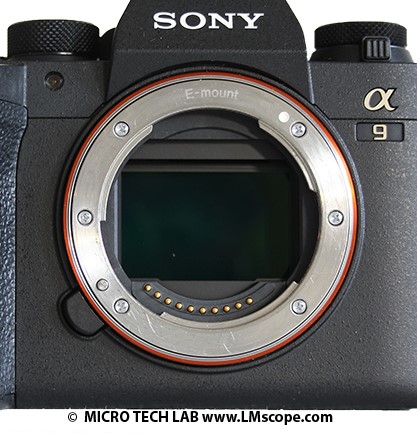
The Alpha 9 II has a TFT screen with a size of 7.5 cm (3 inches) and touch control. The flexible tilt allows moving and rotating the screen upward and downward, which means that the camera can be attached to a vertical phototube without any problems because the viewing angle can be adjusted to the most ergonomic position.
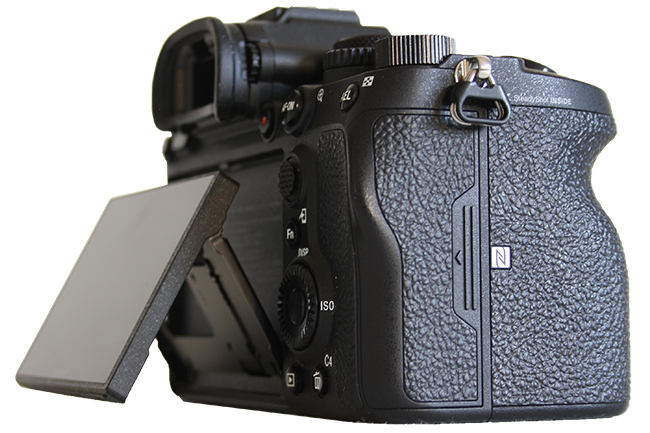
In terms of video capabilities, the camera is also a strong performer: 4K video recording (30 fps with a resolution of 3,840 x 2,160) with full pixel readout without. The camera also supports the XAVC S format with bit rates up to 100 Mbps.
The CMOS full-frame sensor is exceptionally light sensitive and features a wide dynamic range. Sensitivity ranges from ISO 100 to 51,200 in automatic mode, and from ISO 50 to 204,800 in manual mode. This makes the Alpha 9 II a contender for fluorescence microscopy. To achieve the camera’s full dynamic range, we recommend that you use low ISO settings whenever possible.
Demo photo of plastic parts with drilled holes:
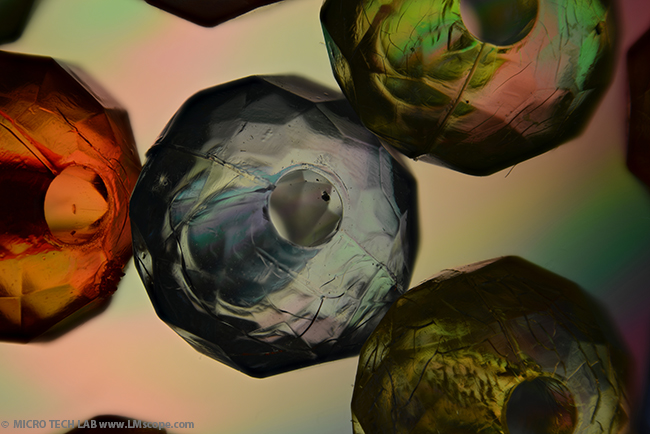
The camera has dual media slots that are both compatible with UHS-I and UHS-II SD cards.
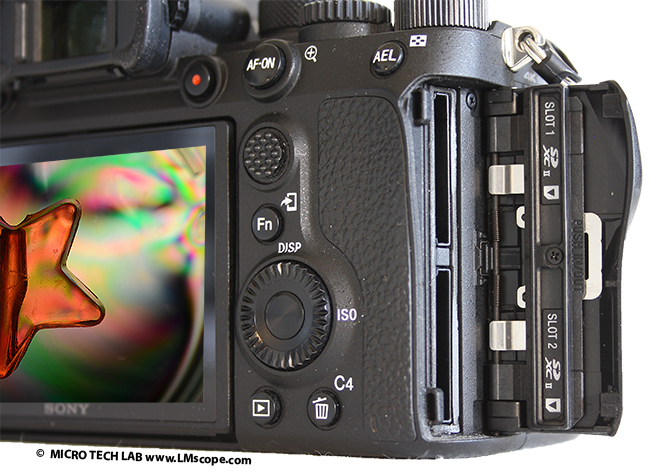
A USB Type-C 3.2 Gen 1) port supports fast data transfer and allows the camera to be charged or powered while in operation. To use this feature, USB Power Supply On must be selected in the camera menu:
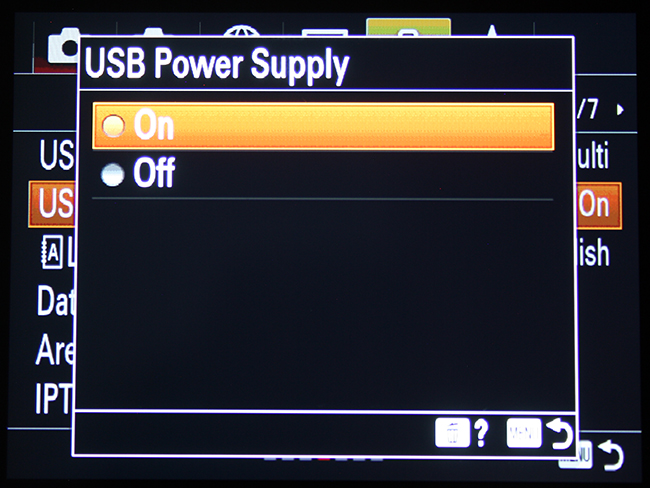
One outstanding quality feature of the Alpha 9 II is its connectivity:
- Integrated port offers 1000BASE-T speeds for quick wired LAN sharing
- 5 GHz Wi-Fi® for high-speed data transfer
- HDMI video output in 4K resolution
- Remote Camera Tool
- Imaging Edge Mobile app
- Capture One (for Sony)
- Imaging Edge Remote, Viewer and Edit for desktop
As shown in the list above, the Alpha 9 II has a built-in 1000BASE-T port, enabling high-speed gigabit data communication. This allows large image files to be transferred to an FTP server. The camera also provides upgraded network functionality, which is particularly important in the professional field, for example when several cameras need to be integrated into the network environment of a studio or lab. Additionally, file transfer over SSL or TLS encryption is supported for increased data security. The Alpha 9 II can be connected to a local network for tethered shooting in live view using Sony’s Imaging Edge Remote software application.
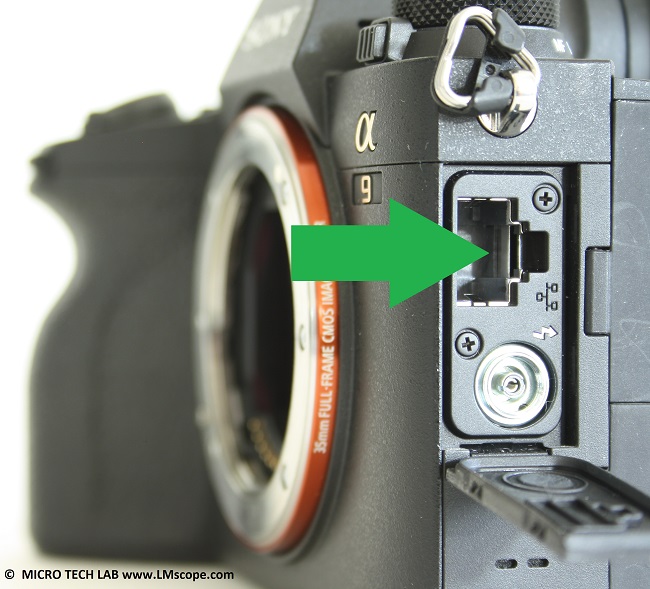
For photomicrography applications, we recommend controlling the camera remotely from a PC/Mac or tablet/smartphone wherever possible. The Remote Function can be enabled in the camera menu:
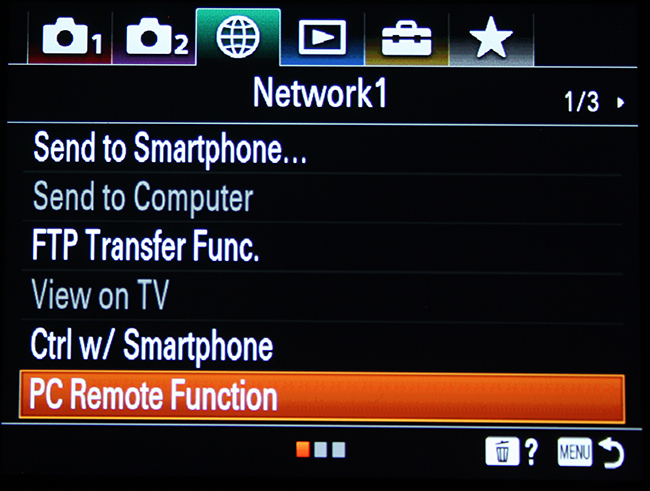
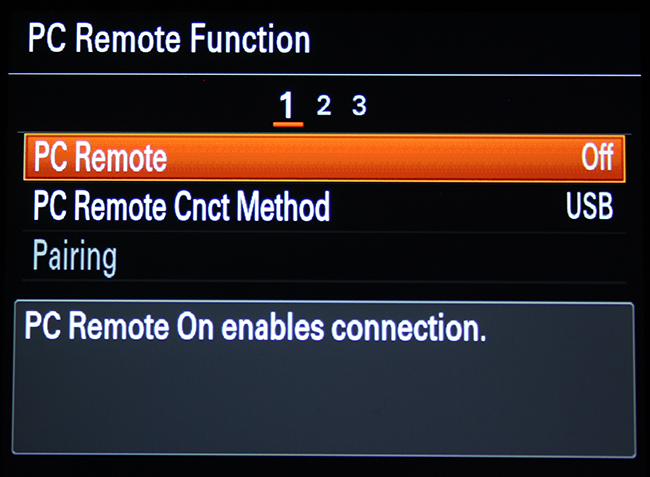
Sony’s Imaging Edge desktop application includes the Remote, Viewer, and Edit functions of the Imaging Edge software suite and helps to enhance the quality and efficiency of photographic imaging. The software enables remote camera control, remote shooting and access to important settings. The captured images are stored directly on the computer’s hard drive and can then be edited. This allows working with large data volumes, and the images can be stored uncompressed in 14-bit RAW format. The software also increases workflow efficiency and eliminates the camera shake you would get from adjusting your settings and pushing the shutter manually. Click here for a detailed test report on this software. Alternatively, the Alpha 9 II can be controlled with the Capture One software for Sony (read more here). It is also compatible with the iMovie and Final Cut Pro X video editing programs.
The Alpha 9 II also features a Voice Memo function – a completely new feature that allows spoken information to be attached to images.
As a general rule, we recommend supplying continuous power to the camera when it is attached to a microscope in a lab or studio, in order to prevent the camera from suddenly turning off. This power can either be provided via a USB cable with a wall plug or via a battery adapter (NPA-MQZ1K) connected to an external power source.
Connection to a large monitor to control image quality:
The Alpha 9 II is equipped with an HDMI® port (3,840 x 2,160 (25p), 1,920 x 1,080 (50p)) to display the high-quality images and videos captured on a large external monitor.
The ability to connect the camera and computer via 5 GHz Wi-Fi® provides the speed needed to transfer image data to the computer in high speed while shooting images remotely from a PC/Mac. This frequency range is new and therefore rarely used, which translates into higher data transfer speeds. However, to use the GHz band, the Wi-Fi communication module used must also be compatible with this frequency.
Conclusion: At a price tag of currently € 5,399.00, the Alpha 9 II is not cheap but has a lot to offer, including a solid build quality and state-of-the-art camera technology. With its high-speed continuous shooting performance and a 1000BASE-T port for faster wired LAN sharing, the camera is clearly superior to its sister models and the competition and is excellently suited for microscopy applications. The camera can be connected to the microscope with our LM microscope adapter solutions, which are compatible with almost any microscope. With Sony’s software tools, the Alpha 9 II can also be conveniently controlled from a computer or mobile device. If the number of pixels is too low for special applications, or if a higher video resolution (8K) is required, Sony also offers an interesting alternative to the Alpha 9 II – the Sony A1 – with features similar to those of the A 9, but a 50 MP sensor.
New LM Digital Adapter for: Sony Alpha 7R V / Sony Alpha 1 / Sony FX3 Cinema Line / Sony Alpha 9 II (ILCE-9M2) / Sony Alpha 9 / Sony Alpha 7R IV / Sony Alpha 7S II / Sony Alpha 7S III / Sony Alpha 7R III / Sony Alpha 7R II / Sony Alpha 7C / Sony Alpha 7S / Sony Alpha 7III / Sony Alpha 6700 / Sony Alpha 6600 / Sony Alpha 6400 / Sony Alpha 6100 / Sony ZV-E10 / Sony Alpha 6300 / Sony Alpha 6500 / Sony Alpha 99 II (SLT-A99 II) /